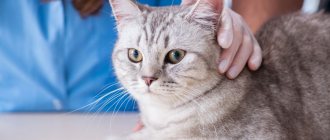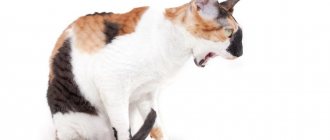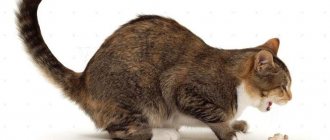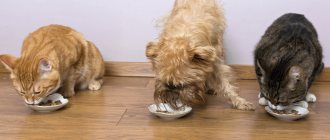25106Administration
6
A pet's illness always brings owners a lot of worries and troubles. A cheerful and mischievous pet suddenly becomes sad and lethargic - this is familiar to many. What if a cat vomits white foam? From a medical point of view, the gag reflex is considered as a natural physiological process that helps the animal empty its stomach.
There may be several reasons that provoke white vomiting. If white foamy vomiting in a cat is repeated many times, this may indicate some kind of disease and cannot be avoided without the help of a veterinarian.
Causes of vomiting in cats and kittens
Vomiting white foam in cats and kittens can be a protective reaction to the entry of pathogenic bacteria and irritating substances into the digestive system.
This symptom may appear if the animal has eaten something wrong. Pay attention to the vomit. Don't worry if the white foam is a smooth consistency. This may mean a temporary disruption to the digestive system.
Let's look at why a kitten may vomit white foam:
- Overeating, feeding too large pieces of food.
- Hunger. If an animal does not eat for a long enough time, gastric juice begins to irritate the mucous membranes of the digestive organs. As a result, the kitten vomits white foam.
- Too abrupt a transition from one diet to another.
- Feeding food that is harmful to the kitten (fatty, fried, smoked).
- Stale food, ready-made economy class rations.
- Eating inedible objects.
- Poisoning with chemicals (household chemicals, medications, alcohol).
- Consequences of vaccination.
- Inflammatory diseases of the gastrointestinal tract. Symptoms appear immediately after feeding. The kitten first burps, then vomits. If severe diarrhea is added to vomiting, the animal may die.
- Kidney diseases. Vomiting is accompanied by thirst and difficulty urinating.
- Infectious diseases. The most dangerous are feline distemper and panleukopenia, which can be fatal. The kitten vomits white or yellowish foam, attacks occur quite often.
- Respiratory diseases of viral, bacterial etiology. In this case, vomiting is accompanied by a cough, and a small amount of blood is present in the foam.
- Inflammatory diseases of the adrenal glands. The result is a disruption of the normal process of cortisone synthesis, which is accompanied by vomiting, diarrhea, and muscle weakness.
- Worm infestation. Vomiting is caused by toxins that are formed during the life of parasites.
A possible cause of vomiting may be a large amount of fur entering the stomach if the animal licks itself frequently. This process is typical for long-haired animals.
Treatment
Treatment for single vomiting caused by wool, grass, overeating, hunger or vaccination is usually not required. If vomiting recurs and the pet’s condition worsens (refusal to eat, lethargy), a visit to the clinic is mandatory.
If you are vomiting due to food, you need to reconsider your diet. When feeding with industrial food, you need to try options for sensitive digestion, and when eating a homemade diet, contact a nutritionist to create a proper and balanced diet.
Vomiting due to estrus or pregnancy requires treatment if there is any pathology. In case of estrus, which is constantly severe, sterilization may be recommended, and in case of pregnancy pathology, its termination.
Vomiting due to stress in each specific case requires an individual approach. Only a doctor can detect and help eliminate the cause of a cat’s stress, as well as select an individual regimen for administering sedatives.
In case of vomiting caused by helminths , deworming is mandatory. To determine the frequency of treatments and select the right drug, it is recommended to contact a veterinary clinic or contact a veterinarian online. Under no circumstances should you use medications - they can poison the animal.
If vomiting is caused by the presence of a foreign body in the pet's stomach or intestines, surgical intervention is necessary. In this situation, it is strongly recommended not to use petroleum jelly and other folk remedies, as you may waste precious time. If the condition is neglected, pets may develop intestinal necrosis and severe intoxication of the body, often leading to death.
For vomiting caused by other causes (drug poisoning, oncology, kidney disease, etc.) , treatment is developed individually in each case and depends on many factors (age of the pet, presence of concomitant pathologies, severity of the disease, etc.).
Help at home
You can help your pet at home only if the vomiting occurred once and he is in good health and has no other complaints. For example, if an animal vomits something that it recently ate, there is no need to give it anything.
It is also not recommended to self-prescribe antiemetic drugs, as they can not only blur the picture of the disease, but also worsen the pet’s condition (for example, when eating a foreign object).
Diet
For most diseases of the gastrointestinal tract, manifested by vomiting, a diet (food labeled Gastro Intestinal) can help. But it is worth considering that, for example, in case of vomiting caused by kidney disease, a different diet is needed (food labeled Renal). When feeding your pet homemade products, a consultation with a veterinarian nutritionist is necessary to correct the diet.
What to do if your cat is vomiting?
So, what should you do if your cat is vomiting white foam? Observe your pet for 24 hours. If your cat vomits but is still acting normally, signs of discomfort may disappear the next day.
If you suspect poisoning or an exacerbation of gastrointestinal diseases, you can try to help the cat by giving it a fasting day. This will restore the functioning of the damaged organ.
The next day, the animal’s condition should return to normal and the vomiting should stop. On the first day after the fasting day, give your cat rice cooked in chicken broth.
Feed your pet more often (up to 6 times a day), in small portions. In subsequent days, reduce the number of feedings and increase the amount of food. Then gradually transition the cat to a regular diet.
If the vomiting was caused by a common stomach upset, give your pet a mint infusion. Pour 1 teaspoon of herb into 1 cup of boiling water and leave until cool. The drink should be warm. Give your cat 1 tablespoon immediately after vomiting.
Symptoms
Foaming at the mouth of a cat is a cause for concern for the animal owner. The cause may be either a normal physiological condition (with regurgitation of hairballs) or the development of serious dangerous diseases (rabies). Especially if the saliva foams at the mouth. In such cases, it is recommended to immediately isolate the cat and take it to a veterinary clinic.
The appearance of foam in a cat’s mouth when vomiting, which occurs as a result of prolonged fasting, intoxication, and stressful experiences, as a rule, is not distinguished by other characteristic signs other than nausea. The erupted gastric contents have no foreign odors or impurities.
If there are foreign impurities in the vomit, an unusual yellow or green color, as well as a foul odor, you must contact a veterinary hospital and show your pet to a doctor. The appearance of the following characteristic symptoms requires immediate intervention from a specialist:
- the cat vomits too often, vomiting almost never stops;
- body temperature increases or, on the contrary, decreases;
- there is a cough, discharge from the eye and nasal cavity;
- appetite is impaired;
- the general condition of the animal is depressed;
- profuse diarrhea appears.
When a cat vomits pink liquid with foam, you cannot hesitate. The cause of such vomiting may be a stomach ulcer or a perforation of the esophagus. Pink color indicates blood impurities and indicates damage to the mucous membrane of one part of the digestive tract.
The color and presence of particles in the vomit can characterize the degree of neglect of the pathological condition:
- vomit with white foam is most often a sign of prolonged starvation of a pet;
- the presence of mucous white inclusions in the liquid ejected by the stomach indicates that the cat is infected with helminths;
- if a cat is vomiting yellow foam, the cause may be a dangerous illness - carnivore plague or panleukopenia;
- the gray color of the vomit indicates a violation of the diet and the presence of remains of granulated food;
- dark green, almost black color of vomit may be evidence of oncology in the digestive tract;
- yellow vomiting occurs when there is a violation of the functional characteristics of the gallbladder and liver structures;
- vomiting in a green fountain – intestinal obstruction;
- vomiting with feces is a sign of injury to the lower intestines.
Severe, ongoing nausea and vomiting lead to rapid dehydration and disruption of water and electrolyte balance. Visible mucous membranes turn pale, become dry, and saliva is viscous. The animal is depressed, and in advanced cases, seizures or convulsions are noted. It is important to contact a specialist in a timely manner, since any delay can result in the death of the cat.
In what cases should you contact a veterinarian?
The situation becomes more complicated when the pet feels sick and vomits for more than a day, it becomes weak and lethargic and looks sick. If the cat does not go to the toilet or does not allow his stomach to be touched, you should urgently contact a veterinarian.
Other reasons to contact a specialist:
- After a starvation diet, the pet’s condition does not improve; he often vomits (several times an hour).
- If your cat doesn't eat anything all day. In this case, foamy vomit is most likely a sign of a serious illness.
- Vomiting is accompanied by severe thirst, and the cat does not go to the litter box. This indicates kidney pathology.
- Diarrhea, fever (above 38-39 ºС).
- Cramps. The symptom indicates damage to the central nervous system.
- Bloody discharge can be seen in the vomit.
- If your cat regularly spits up fur, his digestive system is not working properly. Your pet may have diseases of the gallbladder, pancreas or rectum.
Vomiting that does not stop for more than a day leads to dehydration. This condition poses a serious threat to life.
The following sign indicates severe dehydration with prolonged vomiting: lift an area of skin with your fingers and release it, it will slowly return to its original shape.
To prevent the death of the animal, you should not self-medicate. Be sure to show your cat to a veterinarian, who will determine the cause of vomiting and provide adequate therapy.
Avoid and treat vomiting with white foam
After identifying the most common reasons why a cat vomits white foam, we will see some recommendations on what we can do to prevent this situation and how to deal with this situation. These are the following:
- Vomiting is a symptom that should not be left untreated by contacting our veterinarian.
- It is recommended that you write down the symptoms we observe. In case of vomiting, you should look at its composition and frequency. This will help the veterinarian make a diagnosis.
- We must provide our cat with an adequate diet to meet her nutritional needs, avoiding foods that may make her feel unwell or trigger an allergic reaction.
- We must also store it in a safe environment to prevent it from being ingested by a potentially dangerous item.
- Regarding hairballs, brush your cat, especially during shedding season, as this will help get rid of all the dead hair that is about to fall out.
- It is important to keep a calendar of internal and external deworming, even if the cat does not have access to the outside. Our veterinarian will give us the most appropriate recommendations based on our circumstances.
- If a cat has vomited once and is in good spirits, we can wait and watch before contacting the vet. On the contrary, if the vomiting recurs, we see other symptoms, or our cat is decomposed, we should go straight to the vet without trying to treat it ourselves.
- Finally, from the age of 6-7 years, it is convenient that at least once a year we take our cat to the veterinary clinic for a full examination, including analytics. This is justified because with such control, some of the diseases we have talked about can be diagnosed at an early stage, which allows us to begin treatment before the first symptoms appear.
What to do if your cat is vomiting yellow foam?
If a cat vomits yellow foam, it means that bile has entered its stomach. The cause is diseases of the gastrointestinal tract (gastritis, colitis), biliary tract.
Yellowish vomiting in a cat can occur due to calcivirosis, a sudden change in diet, or a foreign body entering the stomach. If your pet has eaten stale or low-quality food, the load on the liver increases. In this case, vomiting of yellow liquid may also occur.
If you suspect that an inedible object or poor-quality food has entered the stomach, you need to provoke vomiting.
Give the animal a saline solution. To prepare it, stir 1 tablespoon of salt in 1 glass of warm water. Drink the solution until the cat begins to vomit.
If vomiting yellow foam was caused by poisoning, give your pet activated charcoal. In case of exacerbations of gastrointestinal diseases, exclude rough, fatty foods from the animal’s diet.
In severe cases, when vomiting with yellow foam was caused by infections, the cat should be taken to the veterinarian. In this case, you need to make droppers with saline solutions and medications.
Cat vomits white due to illness
Please note! Symptoms of vomiting in a kitten can indicate a hundred different diseases and abnormalities. It is possible to cure a pet only if the root cause of the gag reflex is accurately established, so you cannot do without a good veterinarian.
White vomiting, as one of the symptoms, is associated with many feline pathologies and diseases:
- Surgical interventions . If the pet has undergone surgery under anesthesia, then often after this the cat experiences attacks of white vomiting and foam from the mouth and nose. After surgery and anesthesia, the animal should remain in conditions of rest and comfort.
- Vaccination . In the modern world, vaccination is the key to a long and healthy life for a cat. Sometimes a consequence of vaccination can be foam and white vomit. Normally, this condition should not last more than 2-3 days in a row.
- Viral infections . Among the most dangerous diseases leading to death are herpes and corona virus infections, rabies, feline immunodeficiency, Aujeszky's disease and panleukopenia. The infectious source is an animal carrier of the virus. Along with white foam and a gag reflex, the pet experiences weakness and refusal to eat, excessive salivation, and an increase in body temperature. One of the most dangerous symptoms is when a cat vomits foam mixed with blood.
- Pathologies of the digestive system . Gastrointestinal diseases in cats always resolve with profuse vomiting and intestinal upset (diarrhea or constipation), severe weight loss occurs with good appetite. In this case, the vomit comes with blood, bile and foam. The animal refuses to eat and drink, and the opposite effect may occur - the pet often eats a lot and actively drinks liquids. The most common of them are ulcers, gastritis and enteritis.
- Helminths . The cat's body is attacked by up to one hundred thousand varieties of worms, which can parasitize the vital organs of the animal. At the same time, the cat exhibits a number of other signs - total hair loss, alternating diarrhea and constipation, changes in appetite and mood, itching in the anus, vomiting with white foam and worms. Against the background of intoxication, immunity decreases, dystrophic changes occur in many internal organs and systems. The animal easily becomes infected and often gets sick, and as a result may even die.
© shutterstock
If a kitten vomits while he is eating, and the gag reflex occurs mixed with belching and white foam, then this indicates muscle weakness of the sphincter located between the esophagus and the stomach. The bolus of food does not pass into the gastric region and is regurgitated by the animal.
The right solution is to feed your pet finely ground food fractionally (5-6 times a day) and in small doses. As the kitten gets stronger, its esophageal muscle will return to normal.
Types of vomiting
In most cases, the cause of vomiting can be determined by the consistency and type of vomit.
- If an animal vomits yellow foam, this means that during the digestion of food a certain amount of bile enters the cat’s stomach. This often happens with gastritis, colitis, and problems with the biliary tract. Against the background of bile secretion, the liver is cleansed of harmful microorganisms and toxic substances. Thus, a cat can vomit due to calcivirosis, feline distemper, a change in food, or a small foreign object entering the stomach.
- The animal vomits clear liquid or saliva due to a rather dangerous disease - distemper. At the same time, the cat can also vomit yellow liquid or foam, which does not contain undigested food and hairballs. With each subsequent urge, the cat gets worse, he becomes lethargic and apathetic, and hides in a dark place. When a cat vomits a clear, almost colorless liquid, its body loses water, which leads to rapid dehydration.
- It happens that a cat may vomit right after eating. The reason for this is intestinal parasites, which are found even in domestic cats. Also, a cat may regurgitate undigested food that is not absorbed by its body. This condition can manifest itself with intestinal obstruction, gastritis, colitis, hepatitis, or pancreatitis. An animal may regurgitate food it has just eaten due to a certain amount of hair that has accumulated in its stomach or due to overeating.
- If helminths live in a cat's body, the cat may well vomit worms. In such a situation, you should take preventive measures, limit your pet’s contact with people and make a visit to the veterinarian. You can start taking antiparasitic drugs only after passing a stool test, which determines the type of worms living in the animal’s body. When treating a cat for worms, clean and fresh water should always be present in its drinking bowl.
Something else interesting: Roundworms in cats
[custom_ads_shortcode2]
[custom_ads_shortcode3]
When to see a doctor
If vomiting occurs repeatedly, you should not postpone a visit to the veterinarian. In addition, there are a number of accompanying signs indicating the need for urgent medical attention:
- The cat has no interest in food. Together with foamy vomiting, this is a very alarming symptom, raising suspicion of liver lipidosis.
- Intense thirst. When an animal does not move away from a cup of water, there is a high probability of kidney pathology.
- The cat does not urinate for a long time, although he drinks a lot.
- Vomiting occurs very often - up to several times in one hour.
If you notice signs of illness in your cat, you should not wait for a miracle or self-medicate. Vomiting that continues for more than a day can cause dehydration, which poses a serious threat to the pet’s life. Timely professional assistance will help alleviate the animal’s condition and prevent its death.
[custom_ads_shortcode1]
First aid
What should you do if your cat is vomiting white foam, but there are no obvious symptoms indicating a serious illness? When your pet’s condition does not cause concern, and you cannot get to the nearest veterinary clinic, you can try to help him with a daily starvation diet. During this time, the digestive system is unloaded, due to which the damaged organ is restored.
The next day, when the condition stabilizes and the vomiting stops, you can gradually give rice cooked in chicken broth. The cat must be fed frequently (up to six times a day), but in small portions. Every day the volume of food is increased, while simultaneously reducing the number of feedings.
For common stomach upset, mint decoction is effective. After brewing and cooling it to 37⁰C, pour one tablespoon into the cat’s mouth immediately after vomiting. If there is a suspicion of accumulation of hairballs in the pet's intestines, the cat is given a teaspoon of oil 3 times a week, adding it to the food. It has a laxative effect, which leads to the cessation of vomiting.
[custom_ads_shortcode3]
Examination of cats
To identify the cause of frequent vomiting, the veterinarian interviews the cat's owner and carefully examines the animal. If necessary, a number of studies are carried out. This approach allows you to quickly find the cause of the illness and begin to treat your sick pet. The inspection is usually carried out in several successive stages and consists of the following points:
- Interview the owner to obtain information about the frequency and duration of vomiting.
- Clarification of the cat’s diet, as well as the possibility of foreign objects entering the digestive tract.
- Determining the type and thickness of vomit, finding out information when the animal began to vomit.
- Examination of the animal, determination of general condition and reflexes.
- Clarification of information about chronic cat diseases.
If the cat has only once vomited clear liquid with a small admixture of hair, then it is worth observing the pet throughout the day. Most often, this condition stabilizes very quickly, and after a few hours the cat is playful and active. However, when vomiting becomes indomitable and the animal becomes lethargic and apathetic, dehydration sets in very quickly, which causes irreversible processes in the body. You can’t hesitate here; only a doctor can provide help. In severe cases, surgery and intravenous fluids may be needed.
The owner should be wary if the animal does not allow its belly to be touched or to be picked up. This may indicate an inflammatory process in the abdominal area.











